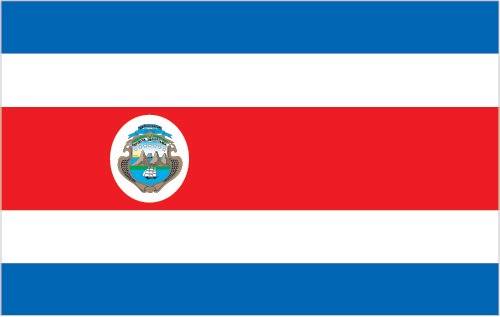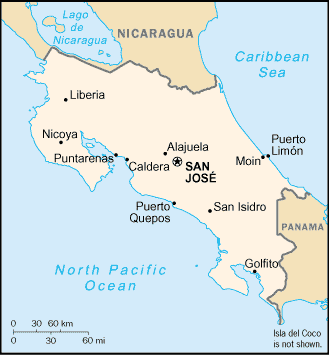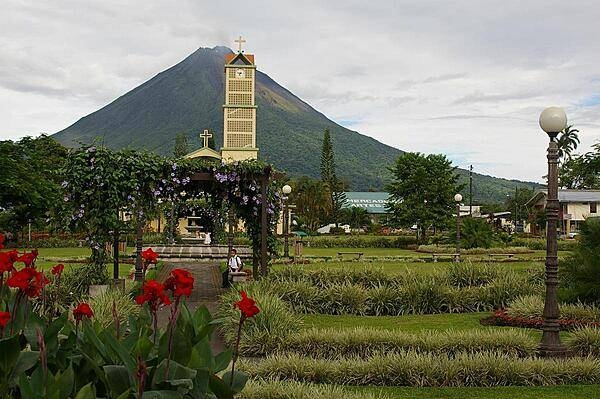13 Costa Rica

Five horizontal bands of blue (top), white, red (double width), white, and blue, with the coat of arms in a white elliptical disk placed toward the hoist side of the red band. Costa Rica retained the earlier blue-white-blue flag of Central America until 1848 when, in response to revolutionary activity in Europe, it was decided to incorporate the French colors into the national flag and a central red stripe was added. Today the blue color is said to stand for the sky, opportunity, and perseverance, white denotes peace, happiness, and wisdom, while red represents the blood shed for freedom, as well as the generosity and vibrancy of the people.
Flag courtesy of the CIA World Factbook


Volcano Arenal, seen here from the town of La Fortuna, was dormant for hundreds of years until it suddenly erupted in 1968. It remained active, off and on, for decades, but has been relatively quiescent since 2010, with only occasional rumbles.
Photo courtesy of the CIA World Factbook
Government
According to Britannica, Costa Rica is governed by its constitution of November 1949, the 10th in its history. A president, two vice presidents, and a unicameral Legislative Assembly are elected at the same time for a term of four years, the assembly by proportional representation. Presidents may not run for immediate reelection, though they are eligible to serve again after sitting out two successive presidential terms. Since the adoption of the constitution of 1949, Costa Rica has given an unusual degree of power to autonomous agencies, including state-financed universities and regional development institutes such as the National Insurance Institute, the Social Security Institute, and the Costa Rica Tourist Institute. These agencies provide additional opportunity for participation in government, but because of powers independent of the central administration they have made central planning more challenging.
The country’s seven provinces are administered by governors appointed by the president. The provinces represent judicial and electoral jurisdictions; most government agencies with their own administrative branches may not account for provincial boundaries. Each province is divided into cantones (cantons), and each canton is divided into distritos (districts). Councilmen for the cantons are elected locally, but budgets for all political units are approved by the national government, which controls nearly all the funds available to local governments.
In the Costa Rican system of justice, cases may be decided by a single judge or by a panel of judges; the jury system is not used, but the courts are generally noted for their fairness. Capital punishment is banned, and sentences to the penitentiary must be for a stated number of years. The highest court is the Supreme Court of Justice. Magistrates of the Supreme Court are chosen by the assembly for eight-year terms and automatically continue for a second eight-year term unless removed by a two-thirds vote. An independent Supreme Electoral Tribunal, which has extraordinary powers during elections, oversees the election process.
General Directorate of Civil Aviation
The General Directorate of Civil Aviation is dedicated to the planning, regulation, provision, and promotion of civil aviation activity in Costa Rica. Through their Quality Management System, they are committed to:
– Guarantee the operational safety and sustainable development of the civil aeronautical activity of Costa Rica.
– Comply with national and international regulations applicable to their operations.
– Satisfy the requirements of the users and the processes incorporated into the Management System.
– Seek efficiency through the continuous improvement of their Management System.
Airspace
SkyVector – Google Maps – ADS-B Exchange
ICAO countries publish an Aeronautical Information Publication (AIP). This document is divided into three parts: General (GEN), En Route (ENR) and Aerodromes (AD). ENR 1.4 details the types of airspace classes they chose to adopt from classes A through G.
COCESNA
The Central American Corporation for Air Navigation Services (COCESNA) is an International Organization for Central American Integration, non-profit and public service, with legal status and financial autonomy, created on February 26, 1960 and governed by a Board of Directors, which it is constituted in its highest collegiate body, which is made up of the representatives of the signatory States of its Constitutive Agreement; established with well-defined objectives and purposes to respond and jointly comply with civil aviation international commitments contracted as signatory countries of the Convention on International Civil Aviation of 1944, known as the Chicago Convention. In that order, COCESNA enjoys the exclusive rights to provide Air Traffic, Aeronautical Telecommunications and Radio Assistance services in the territories of the Member States and other services established in the regional plans that have been entrusted to it by the Contracting Parties. under an international agreement. Its operations are fundamentally based on the Standards and Methods recommended by the ICAO. The adherence to the established norms and the search for excellence constitute COCESNA’s fundamental objectives.
As a result of the notable progress in aviation at the end of the 1950s, especially with the entry into service of jet aircraft, the need to modernize and strengthen the region’s air navigation services was valued, for which, in the month November 1959, a meeting with the Directors was held in Guatemala. Generals of Civil Aeronautics of Central America at that time, within which it was agreed to convene a Diplomatic Conference aimed at establishing a specialized regional organization, with the necessary human and financial resources to meet these modern requirements, as well as to unify and coordinate regional intergovernmental efforts and actions that would benefit the users of these services. Therefore, from February 22 to 26, 1960, the V Conference of Directors of Civil Aeronautics was held in Tegucigalpa, Honduras, signing the guidelines of the Central American Corporation of Air Navigation Services -COCESNA, thus marking the beginning of its existence and operation. Consequently and by virtue of its nature, on February 1, 1961, its Constitutive Agreement was registered with the International Civil Aviation Organization – ICAO and on January 2, 1962 with the United Nations (UN). During the year 1963, COCESNA acquires the official recognition of the States of the Central American isthmus, through decrees and laws that ratified its Constitutive Agreement issued by the Legislative Assemblies of each Member State. Costa Rica is a member state of COCESNA.
Drone Regulations
UAS Regulations can be seen on the General Directorate of Civil Aviation website.
You can find restrictions near airports and information on drone registration via an online portal.
Available documents include:
Appendix A1 DO RPAS Formal Application Commercial Operations
Appendix A2 DO RPAS Formal Application Non-Commercial Operations
Appendix B1 DO RPAS CO Operating Qualifications and Specifications
Appendix B2 DO RPAS Operating Conditions and Limitations
Appendix C DO RPAS Limitations on Operation
Appendix D of RPAS System Technical Characteristics
Appendix E DO UAS Operations Manual
Appendix F DO RPAS Operational Safety in the Operation of Remotely Piloted Aircraft Systems
Appendix G DO RPAS Test Flights
Appendix H of the RPAS Maintenance Program
Appendix I DO RPAS Theoretical and Practical Course
Advanced Air Mobility (AAM) Regulations & Policies
None found by the author.
However, should you, the reader, happen to stumble across something to the contrary, please email the author at FISHE5CA@erau.edu and you may be mentioned in the ACKNOWLEDGEMENTS section of this book by way of thanks for contributing to this free eBook!
Advanced Air Mobility (AAM) News
2025 – Aerosolutions, Bluenest place order for 50 Eve eVTOL aircraft
2025
Video courtesy of Advanced Air Mobility Institute from the January 2025 Global AAM Forum. Complete session for Day 3 of this Forum is available on the Advanced Air Mobility Institute YouTube Channel
2024 – EHang´s EH216-S Pilotless eVTOL Successfully Completed Its Debut Flight in Latin America
Short Essay Questions
Scenario-Based Question
You have been hired by a Drone Startup Company. Your boss has immediately assigned this job to you.
They need you to prepare a one-page memo detailing the legalities of using a drone in the town of La Fortuna, pictured above.
They need you to mention any national laws and local ordinances.
They specifically want to know what airspace (insert pictures) you will be operating in and whether or not you need an airspace authorization.
Does it matter whether or not you are a citizen of the country?
Lastly, there is a bonus for you if, as you scroll through this chapter, you find any typos or broken links!
Short Essay Questions
- What are the drone categories?
- How is registration addressed?
- How is remote ID addressed?
- What are the model aircraft rules?
- What are the commercial drone rules?
- Are there waivers or exemptions to the rules? If so, for what?
- Would you share a link to an interactive airspace map?
- How is BVLOS addressed?
- How can you fly drones at night?
- How can you fly drones over people?
- Where do you find drone NOTAMs?
- What are the rules for drone maintenance?
- What are the rules for an SMS program?
- What are some unique rules not mentioned above?
- What are the C-UAS rules?
- What are the AAM rules?

